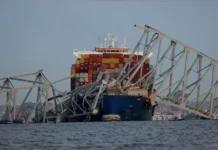Hundreds of dead birds are washing up on Sydney’s iconic beaches.
The corpses of short-tailed shearwatershave been spotted at several shorelines including Bondi, Manly and Cronulla.
The birds are migrating back to southern Australia to breed after spending the summer in Alaska.
![]()
Hundreds of dead birds are washing up on Sydney’s iconic beaches. Pictured: The corpses of short-tailed shearwaters on an Australian beach in October
But, according to experts, a higher number than usual are dying on the way due to a lack of food.
The birds need to be at full strength to make the 14,000km trip over the Pacific but the krill and other fish they feed on have apparently dwindled due to sea temperatures rising.
Each year around 30,000 birds land at Griffiths Island at Port Fairy in Victoria but this time only half that number have made it, according to Peter Barrand, the president of BirdLife Warrnambool.
Explaining why, he told Yahoo News: ‘Water temperatures are rising, the fish shearwaters feed on are not coming into the shallows.
‘There’s certainly something that’s going drastically wrong’.
![]()
Two shearwaters are dead on the sand next to a lifeguard tower at Bondi Beach
BirdLife Australia has rendered the problem a ‘crisis’.
In a statement on its website, the group says: ‘For the fifth consecutive year, the sea surface temperatures off Alaska have been unusually warm, which has led to a dire shortage of the shearwaters’ marine prey, resulting in thousands of dead shearwaters being washed ashore along Alaska’s beaches.
‘According to the U.S. Fish and Wildlife Service, they died of starvation.
‘It wasn’t a single event, though; instead it was a series of catastrophic die-offs.
‘Starting in late June, these die-offs continued along different sections of the Alaskan coast, occurring progressively further south, through into August.
‘Numerous shearwaters also washed up on Russia’s Chukotka Peninsula as well.
‘Although many thousands of birds were found dead and dying on the beach, this is likely the tip of the iceberg.’
![]()
The Short-tailed Shearwater (pictured) is Australia’s most numerous seabird





















